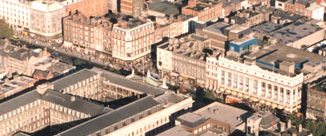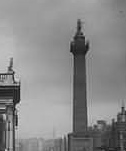O'Connell Street
|
|
Docstatue.JPG
O'Connell Street is Dublin's main thoroughfare. One of Europe's widest streets, it was known as 'Sackville Street' until the early twentieth century, when Dublin Corporation renamed it in honour of Daniel O'Connell, a nationalist leader in the early nineteenth century, whose statue stands at the lower end of the street, facing O'Connell Bridge. The street is located on Dublin's north side.
The thoroughfare has its orgins in a street named Drogheda Street dating from the 17th century. Laid out by Henry Moore, Earl of Drogheda, it was but a third of the width of the present day O'Connell St and extended from the very top of the nothern end down to the current junction with Abbey St. In the 1740s, a wealthy banker and property speculator by the name of Luke Gardiner acquired the upper part of Drogheda St (down to Henry St) as part of a much larger land deal. He demolished the western side of Drogheda St, creating an exclusive elongated residential square 150 feet (46 m) in width. The new, more ordered western side generally featured smaller houses intended for merchants, while the eastern side had larger houses, the grandest of which was Drogheda House, owned by the sixth Earl of Drogheda. Gardiner also laid out a mall down the central section of the street, lined with low granite walls and oblisks topped off with oil-fuelled globe-lamps. It was planted with trees a few years later. He titled the new development 'Sackville Street', also known as 'Sackville Mall', 'Gardiner's Mall' or simply 'The Mall' to most people. Unfortunately, due to the limited lands owned by the Gardiners in this area, the Rotunda Hospital sited just off the street at the bottom of Parnell Square - also developed by the family - was not built on axis Sackville St, terminating the vista. It was always Gardiner's intention to eventually break this grand new street through to the river, however he died in 1755, with his son taking over the estate.
It wasn't until 1777 that the planning body in the city the Wide Streets Commission obtained a financial grant from Parliament that work could begin to realise this plan. For the next 10-15 years work progressed in demolishing a myriad of dwellings and other buildings, laying out the new roadway and building the new terraces. Upon completion in c1785-90 one of the finest streets ever in Europe had been created, if not the finest of its age. The Wide Streets Commission had envisaged and realised marching terraces of unified and porportioned facades extending from the river as far north as Henry St, their simple red brick elevations off-set with a major classical cut stone building near the centre (later to be the GPO built in 1814-18). The street became a commercial success upon the completion of Carlisle Bridge, designed by James Gandon, in 1792 for pedestrians and 1795 for all traffic.

The street itself largely consisted of Georgian and Victorian buildings until the early 20th century. However the Easter Rising in 1916, when a small band of Irish republicans seized the General Post Office (GPO) and proclaimed an Irish republic, led to the street's bombardment by artillery. Much of the street was reduced to rubble, the damaged areas including the whole eastern side of the street as far north as Cathedral St, and the terrace in between the GPO and Abbey St on the western side. Luckily none of the reconstructed buildings were badly, if at all, damaged during the Irish Civil War (1922–1923), its effects largely confined to the northern end of the street - with the entire terrace north of Cathedral St to Parnell Square being destroyed, as well as a few buildings on the north-western side. As a result, only one Georgian townhouse remains on the street today, though there are still some other Georgian buildings extant on the corner with Henry St, as well as some masked behind Victorian facades on the lower end of the street. The General Post Office itself was destroyed in 1916 and was rebuilt between 1924-29. Today, most of the buildings on the street date from the 1920s and 1930s. Apart from the GPO, the most famous buildings on the street include the Gresham Hotel (finished 1927), the Royal Dublin Hotel (1963) and Clerys department store (reopened 1922). However poor planning controls in the 1970s and 1980s allowed cheap shops and burger joints to open. After a couple of decades of neglect, the street has being undergoing a form of renaissance, with new street furnishings and the Spire of Dublin, the world's tallest sculpture, which was erected in January 2003.
The street has a number of major monuments, including statues of late nineteenth century Irish political leader Charles Stewart Parnell, radical early twentieth century trades union leader Jim Larkin and Daniel O'Connell, who was the dominant force in Irish politics from the late 1820s until his death in 1847. One monument in particular, Nelson's Pillar, honouring British Admiral Horatio Nelson, dominated the streetscene, offering an unparalleled viewing platform to which people could climb and see the city. The monument, which stood at the junctions of Henry Street, Talbot Street and Henry Street, was controversially blown up by Irish republicans in March 1966. The controversial Spire of Dublin, has been erected on the site of the pillar.

Dubliners (who are famous for giving blunt nicknames to monuments) used to nickname the street 'the street of the Three Adulturers' because of the allegations of adultery made against the three principal figures on the street commemorated by statues; Parnell, Nelson and O'Connell. It was also noted humourously that the statue of Charles Stewart Parnell, on which appears his famous words "No man has a right to fix the boundary to the march of a nation. To say to his country 'thus far shall thou go and no further' are quoted, points to the Rotunda Hospital nearby, once Dublin's main maternity hospital, as though he was encouraging the Irish nation to outbreed its enemies.
Among the major buildings near to O'Connell Street on Dublin's northside are the GPO, the Pro Cathedral (the church which serves as Dublin's de facto Roman Catholic cathedral, though it has never been raised formally to cathedral status, hence the name) and the Rotunda Hospital which serves as North Dublin's main maternity hospital. From the lower end of the street, facing O'Connell Bridge, one can see the famous James Gandon-designed Custom House while looking directly over O'Connell Street, one can see Trinity College Dublin and the Irish House of Lords entrance to the old parliament building. The north of the street links into Parnell Square (formerly Ruthland Square) while the south meets Dublin's quays.

